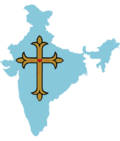| Saint Francis CSI Church, Fort Kochi | |
|---|---|
 Front side of the Church | |
 | |
| 9°57′57″N76°14′28″E / 9.965945°N 76.241102°E | |
| Location | Kochi, Kerala |
| Country | India |
| Denomination | Church of South India |
| History | |
| Consecrated | 1506 |
| Architecture | |
| Completed | 1516 |
| Administration | |
| Diocese | Kochi Diocese |
Saint Francis Church, in Fort Kochi, Kochi, originally built in 1503, is one of the oldest European churches in India [1] and has historical significance as a witness to the European colonial ambitions in the subcontinent. [2] [3] The Portuguese explorer Vasco da Gama died in Kochi in 1524 when he was on his third visit to India. His body was originally buried in this church, but after fourteen years his remains were relocated to Lisbon and is now interred at Jerónimos Monastery. [4] [5]


